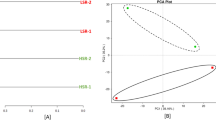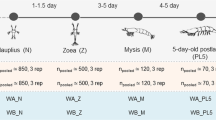Abstract
Bacterial community presumably plays an essential role in inhibiting pathogen colonization and maintaining the health of scallop larvae, but limiting data are available for Yesso scallop (Patinopecten yessoensisis Jay, 1857) larval development stages. The aim of this study was to characterize and compare the bacterial communities associating with Yesso scallop larval development at fertilized egg S1, trochophora S2, D-shaped larvae S3, umbo larvae S4, and juvenile scallop S5 stages by Illumina high-throughput sequencing. Genomic DNA was extracted from the larvae and their associating bactera, and a gene segment covering V3-V4 region of 16S rRNA gene was amplified and sequenced using an Illumina Miseq sequencer. Overall, 106760 qualified sequences with an average length of 449 bp were obtained. Sequences were compared with those retrieved from 16S rRNA gene databases, and 4 phyla, 7 classes, 15 orders, 21 families, 31 genera were identified. Proteobacteria was predominant phylum, accounting for more than 99%, at all 5 larval development stages. At genus level, Pseudomonas was dominant at stages S1 (80.60%), S2 (87.77%) and S5 (68.71%), followed by Photobacterium (17.06%) and Aeromonas (1.64%) at stage S1, Serratia (6.94%), Stenotrophomonas (3.08%) and Acinetobacter (1.2%) at stage S2, Shewanella (25.95%) and Pseudoalteromonas (4.57%) at stage S5. Moreover, genus Pseudoalteromonas became dominant at stages S3 (44.85%) and S4 (56.02%), followed by Photobacterium (29.82%), Pseudomonas (11.86%), Aliivibrio (8.60%) and Shewanella (3.39%) at stage S3, Pseudomonas (18.16%), Aliivibrio (14.29%), Shewanella (4.11%), Psychromonas (4.04%) and Psychrobacter (1.81%) at stage S4. From the results, we concluded that the bacterial community changed significantly at different development stages of Yesso Scallop larvae.
Similar content being viewed by others
References
Amato, K. R., Yeoman, C. J., Kent, A., Righini, N., Carbonero, F., Estrada, A., Gaskins, H. R., Stumpf, R. M., Yildirim, S., Torralba, M., Gillis, M., Wilson, B. A., Nelson, K. E., White, B. A., and Leigh, S. R., 2013. Habitat degradation impacts black howler monkey (Alouatta pigra) gastrointestinal microbiomes. The ISME Journal, 7: 1344–5313.
Angly, F. E., Felts, B., Breitbart, M., Salamon, P., Edwards, R. A., Carlson, C., Chan, A. M., Haynes, M., Kelley, S., Liu, H., Mahaffy, J. M., Mueller, J. E., Nulton, J., Olson, R., Parsons, R., Rayhawk, S., Suttle, C. A., and Rohwer, F., 2006. The marine viromes of four oceanic regions. PLOS Biology, 4: e368.
Bourouni, O. C., Bour, M. E., Mraouna, R., Abdennaceur, H., and Boudabous, A., 2007. Preliminary selection study of potential probiotic bacteria from aquacultural area in tunisia. Annals of Microbiology, 57: 185–190.
Caporaso, J. G., Kuczynski, J., Stombaugh, J., Bittinger, K., Bushman, F. D., Costello, E. K., Fierer, N., Peña, A. G., Goodrich, J. K., Gordon, J. I., Huttley, G. A., Kelley, S. T., Knights, D., Koenig J. E., Ley, R. E., Lozupone, C. A., McDonald, D., Muegge, B. D., Pirrung, M., Reeder, J., Sevinsky, J. R., Turnbaugh, P. J., Walters, W. A., Widmann, J., Yatsunenko, T., Zaneveld, J., and Knight, R., 2010. QIIME allows analysis of high-throughput community sequencing data. Nature Methods, 7: 335–336.
Desnues, C., Rodriguez-Brito, B., Rayhawk, S., Kelley, S., Tran, T., Haynes, M., Liu, H., Furlan, M., Wegley, L., Chau, B., Ruan, Y. J., Hall, D., Angly, F. E., Edwards, R. A., Li, L. L., Thurber, R. V., Reid, R. P., Siefert, J., Souza, V., Valentine, D. L., Swan, B. K., Breitbart, M., and Rohwer, F., 2008. Biodiversity and biogeography of phages in modern stromalites and thrombolites. Nature, 452: 340–345.
Ding, J., Dou, Y., Xu, G. R., Wang, Y. N., and Chang, Y. Q., 2014. Bacterial diversity in the mantle of Patinopecten yessoensis revealed by 454 pyrosequencing. Chinese Journal of Applied Ecology, 25: 3344–3328 (in Chinese with English abstract).
Edgar, R. C., 2013. UPARSE: Highly accurate OTU sequences from microbial amplicon reads. Nature Methods, 10: 996–998.
Edgar, R. C., Haas B. J., Clemente J. C., Quince, C., and Knight, R., 2011. UCHIME improves sensitivity and speed of chimera detection. Bioinformatics, 27: 2194–2200.
Galand, P. E., Casamayor, E. O., Kirchman D. L., and Lovejoy, C., 2009. Ecology of the rare microbial biosphere of the Arctic Ocean. Proceedings of the National Academy of Sciences of the United States of America, 106: 22427–22432.
Gilbert, J. A, Field, D., Swift, P., Thomas, S., Cummings, D., Temperton, B., Weynberg, K., Huse, S., Hughes, M., Joint, I., Somerfield, P. J., and Mühling, M., 2010. The taxonomic and functional diversity of microbes at a temperate coastal site: A ‘multi-omic’ study of seasonal and diel temporal variation. PLoS One, 5: e15545.
Gilbert, J. A., Steele, J. A., Caporaso, J. G., Steinbrü ck, L., Reeder, J., Temperton, B., Huse, S., McHardy, A. C., Knight, R., Joint, I., Somerfield, P., Fuhrman, J. A., and Field, D., 2012. Defining seasonal marine microbial community dynamics. ISME Journal, 6: 298–308.
Godoy, F. A., Espinoza, M., Wittwer, G., Uriarte, I., and Aranda, C., 2011. Characterization of culturable bacteria in larval cultures of the Chilean scallop Argopecten purpuratus. Ciencias Marinas, 37: 339–348.
Gomez-Gil, B., Roque, A., Rotllant, G., Peinado, L., Romalde, J. L., Doce, A., Cabanillas-Beltrá n, H., Chimetto, L. A., and Thompson, F. L., 2011. Photobacterium swingsii sp. nov., isolated from marine organisms. International Journal of Systematic and Evolutionary Microbiology, 61: 315–319.
Hidalgo, R. B., Cleenwerck, I., Balboa, S., De Wachter, M., Thompson, F. L., Swings, J., De Vos, P., and Romalde, J. L., 2008. Diversity of vibrios associated with reared clams in Galicia (NW Spain). Systematic and Applied Microbiology, 31: 215–222.
Huber, J. A., Welch, D. M., Morrison, H. G., Huse, S. M., Neal, P. R., Butterfield, D. A., and Sogin, M. L., 2007. Microbial population structures in the deep marine biosphere. Science, 318: 97–100.
Kesarcodi-Watson, A., Miner, P., Nicolas, J. L., and Robert, R., 2012. Protective effect of four potential probiotics against pathogen-challenge of the larvae of three bivalves: Pacific oyster (Crassostrea gigas), flat oyster (Ostrea edulis) and scallop (Pecten maximus). Aquaculture, 344: 29–34.
Kueh, C. S. W., and Chan, K. Y., 1985. Bacteria in bivalve shellfish with special reference to the oyster. Journal of Applied Bacteriology, 59: 41–47.
Lambert, C., Nicolas, J. L., Cilia, V., and Corre, S., 1998. Vibrio pectenicida sp. nov., a pathogen of scallop (Pecten maximus) larvae. International Journal of Systematic Bacteriology, 48: 481–487.
Lane, D. J., 1991. 16S/23S rRNA sequencing. In: Nucleic Acid Techniques in Bacterial Systematic. Stackebrandt, E., and Goodfellow, M. D., eds., John Wiley and Sons Press, Chichester, 115–175.
Lasa, A., Mira, A., Camelo-Castillo, A., Belda-Ferre, P., and Romalde, J. L., 2014. Analysis of the scallop microbiota by means of 16S rRNA gene pyrosequencing. Frontier Marine Science Conference Abstract: IMMR/International Meeting on Marine Research 2014, DOI: 10.3389/conf.FMARS.2014.02.00112.
Liang, B., Luo, M., Scott-Herridge, J., Semeniuk, C., Mendoza, M., Capina, R., Sheardown, B., Ji, H., Kimani, J., Ball, B. T., Van Domselaar, G., Graham, M., Tyler, S., Jones, S. J., and Plummer, F. A., 2011. A comparison of parallel pyrosequencing and Sanger clone-based sequencing and its impact on the characterization of the genetic diversity of HIV-1. PLoS One, 6: e26745.
Liu, J. C., Sun, X. Y., Li M., Zhang, C. Y., Cao, S. Q., and Ma, Y. X., 2015. Vibrio infections associated with Yesso scallop (Patinopecten yessoensis) larval culture. Journal of Shellfish Research, 34: 213–216.
McBain, A. J., Bartolo, R. G., Catrenich, C. E., Charbonneau, D., Ledder, R. G., Rickard, A. H., Symmons, S. A., and Gilbert, P., 2003. Microbial characterization of biofilms in domestic drains and the establishment of stable biofilm microcosms. Applied and Environmental Microbiology, 69: 177–185.
Quast, C., Pruesse, E., Yilmaz, P., Gerken, J., Schweer, T., Yarza, P., Peplies, J., and Glöckner, F. O., 2013. The SILVA ribosomal RNA gene database project: Improved data processing and web-based tools. Nucleic Acids Research, 41: 590–596.
Riquelme, C. E., Araya, R., Vergara, N., Rojas, A., Guaita, M., and Candia, M., 1997. Potential probiotic strains in the culture of the Chilean scallop Argopecten purpuratus (Lamarck, 1819). Aquaculture, 154: 17–26.
Riquelme, C. E., Chavez, P., Morales, Y., and Hayashida, G., 1994. Evidence for parental bacterial transfer to larvae in Argopecten purpuratus (Lamarck, 1819). Biological Research, 27: 129–134.
Riquelme, C. E., Hayashida, G., Araya, R., Uchida, A., Satomi, M., and Ishida, Y., 1996. Isolation of a native bacterial strain from the scallop Argopecten purpuratus with inhibitory effects against pathogenic vibrios. Journal of Shellfish Research, 15: 369–374.
Riquelme, C. E., Jorquera, M. A., Rosas, A. I., Avendaño, R. E., and Reyes, N., 2001. Addition of inhibitor-producing bacteria to mass cultures of Argopecten purpuratus larvae (Lamarck, 1819). Aquaculture, 192: 111–119.
Riquelme, C., Hayashida, G., Toranzo, A. E., Vilches, J., and Chavez, P., 1995. Pathogenicity studies of a Vibrio anguillarum related (VAR) strain causing an epizootic in Argopecten purpuratus larvae cultured in Chile. Diseases of Aquatic Organisms, 22: 135–141.
Romalde, J. L., Diéguez, A. L., Doce, A., Lasa, A., Balboa, S., Ló pez, C., and Beaz-Hidalgo, R., 2013. Advances in the knowledge of the microbiota associated with clams from natural beds. Clam Fisheries and Aquaculture, 163-190.
Sandaa, R. A., Magnesen, T., Torkildsen, L., and Bergh, Ø., 2003. Characterisation of the bacterial community associated with early stages of Great scallop, using denaturing gradient gel electrophoresis (DGGE). Systematic and Applied Microbiology, 26: 302–311.
Schulze, A. D., Alabi, A. O., Tattersall-Sheldrake, A. R., and Miller, K. M., 2006. Bacterial diversity in a marine hatchery: Balance between pathogenic and potentially probiotic bacterial strains. Aquaculture, 256: 50–73.
Shendure, J., and Ji, H., 2008. Next-generation DNA sequencing. Nature Biotechnology, 26: 1135–1145.
Torkildsen, L., Lambert, C., Nylund, A., Magnesen, T., and Bergh, Ø., 2005. Bacteria associated with early life stages of the Great scallop, Pecten maximus: Impact on larval survival. Aquaculture International, 13: 575–592.
Trabal, N., Mazón-Suástegui, J. M., Vázquez-Juárez, R., Asencio-Valle, F., Morales-Bojórquez, E., and Romero, J., 2012. Molecular analysis of bacterial microbiota associated with oysters (Crassostrea gigas and Crassostrea corteziensis) in different growth phases at two cultivation sites. Microbial Ecology, 64: 555–569.
Wang, Q., Garrity, G. M., Tiedje, J. M., and Cole, J. R., 2007. Naive Bayesian classifier for rapid assignment of rRNA sequences into the new bacterial taxonomy. Applied and Environmental Microbiology, 73: 5261–5267.
Author information
Authors and Affiliations
Corresponding author
Rights and permissions
About this article
Cite this article
Sun, X., Liu, J., Li, M. et al. Characterization of bacterial communities associating with larval development of Yesso Scallop (Patinopecten yessoensisis Jay, 1857) by high-throughput sequencing. J. Ocean Univ. China 15, 1067–1072 (2016). https://doi.org/10.1007/s11802-016-3092-8
Received:
Revised:
Accepted:
Published:
Issue Date:
DOI: https://doi.org/10.1007/s11802-016-3092-8




